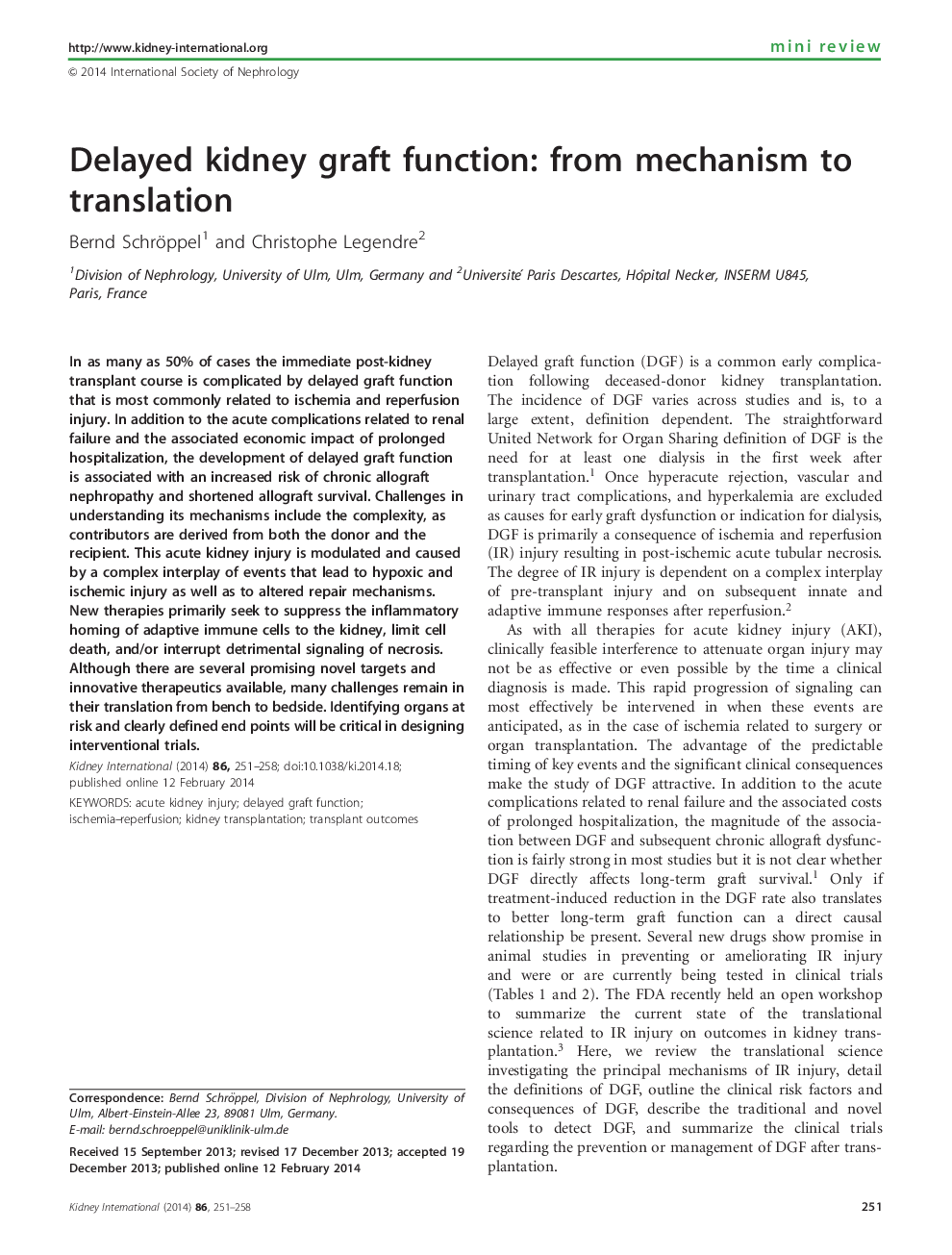| کد مقاله | کد نشریه | سال انتشار | مقاله انگلیسی | نسخه تمام متن |
|---|---|---|---|---|
| 6164379 | 1249469 | 2014 | 8 صفحه PDF | دانلود رایگان |
عنوان انگلیسی مقاله ISI
Delayed kidney graft function: from mechanism to translation
ترجمه فارسی عنوان
تابع پیوند کلیه تاخیر: از مکانیزم به ترجمه
دانلود مقاله + سفارش ترجمه
دانلود مقاله ISI انگلیسی
رایگان برای ایرانیان
کلمات کلیدی
آسیب حاد کلیه، تأخیر تابع گرافت، ایسکمی رپرفیوژن، پیوند کلیه، پیوند پیوند،
ترجمه چکیده
در حدود 50٪ موارد، دوره پیوند فوری بعد از کلیه با تظاهرات تاخیری که بیشترین ارتباط با ایسکمی و آسیب مجدد مجدد را دارد، پیچیده است. علاوه بر عوارض حاد در ارتباط با نارسایی کلیوی و تاثیر اقتصادی مرتبط با بستری طولانی مدت، ایجاد تأخیر در عملکرد گرافت با افزایش خطر نفروپاتی آلوگرام مزمن و کاهش بقای زودهنگام همراه است. چالش ها در درک مکانیسم های آن عبارتند از پیچیدگی، به عنوان مشارکت کنندگان از هر دو اهدا کننده و گیرنده مشتق شده است. این آسیب حاد کلیه مدولاسیون شده و ناشی از یک درگیری پیچیده از حوادث است که منجر به آسیب های هیپوکسیک و ایسکمیک و نیز مکانیسم های اصلاح اصلاح شده می شود. درمان های جدید عمدتا به دنبال مهار التهابی سلول های ایمنی سازگار به کلیه، کاهش مرگ سلولی و / یا جلوگیری از نشانه های مضر نکروز هستند. اگرچه چندین اهداف نویدبخش و جدید درمانی موجود وجود دارد، اما چالش های بسیاری در ترجمه آنها از نیمکت به کنار تخت وجود دارد. شناسایی ارگان ها در معرض خطر و نقاط پایانی مشخص شده در طراحی محاکمات مداخله ای ضروری خواهد بود.
موضوعات مرتبط
علوم پزشکی و سلامت
پزشکی و دندانپزشکی
بیماریهای کلیوی
چکیده انگلیسی
In as many as 50% of cases the immediate post-kidney transplant course is complicated by delayed graft function that is most commonly related to ischemia and reperfusion injury. In addition to the acute complications related to renal failure and the associated economic impact of prolonged hospitalization, the development of delayed graft function is associated with an increased risk of chronic allograft nephropathy and shortened allograft survival. Challenges in understanding its mechanisms include the complexity, as contributors are derived from both the donor and the recipient. This acute kidney injury is modulated and caused by a complex interplay of events that lead to hypoxic and ischemic injury as well as to altered repair mechanisms. New therapies primarily seek to suppress the inflammatory homing of adaptive immune cells to the kidney, limit cell death, and/or interrupt detrimental signaling of necrosis. Although there are several promising novel targets and innovative therapeutics available, many challenges remain in their translation from bench to bedside. Identifying organs at risk and clearly defined end points will be critical in designing interventional trials.
ناشر
Database: Elsevier - ScienceDirect (ساینس دایرکت)
Journal: Kidney International - Volume 86, Issue 2, August 2014, Pages 251-258
Journal: Kidney International - Volume 86, Issue 2, August 2014, Pages 251-258
نویسندگان
Bernd Schröppel, Christophe Legendre,
